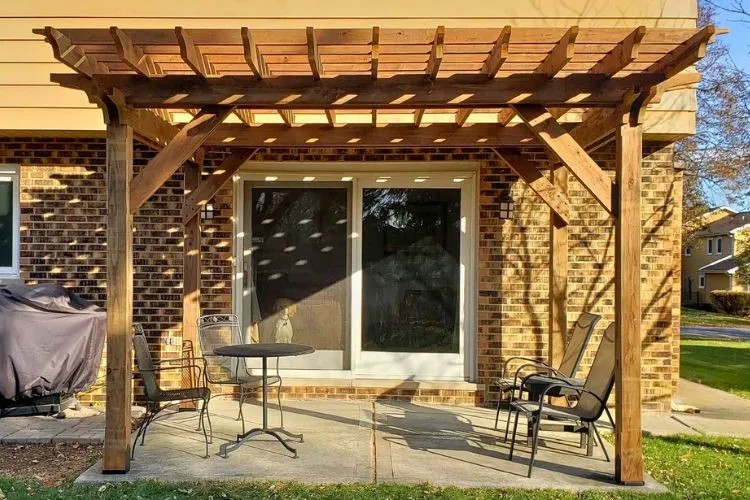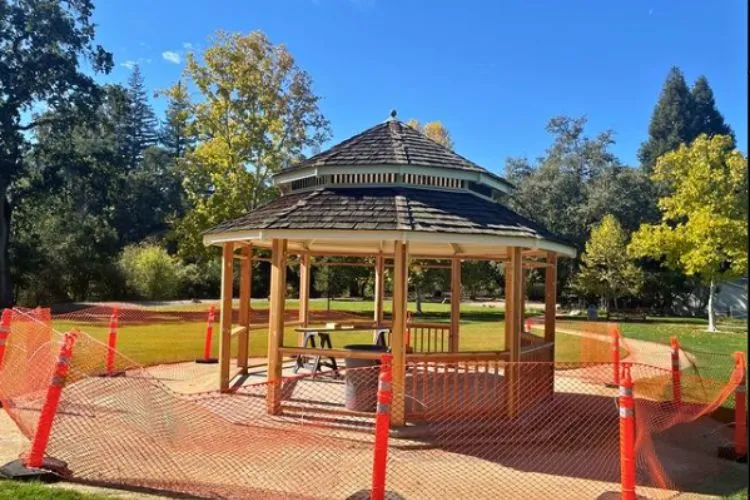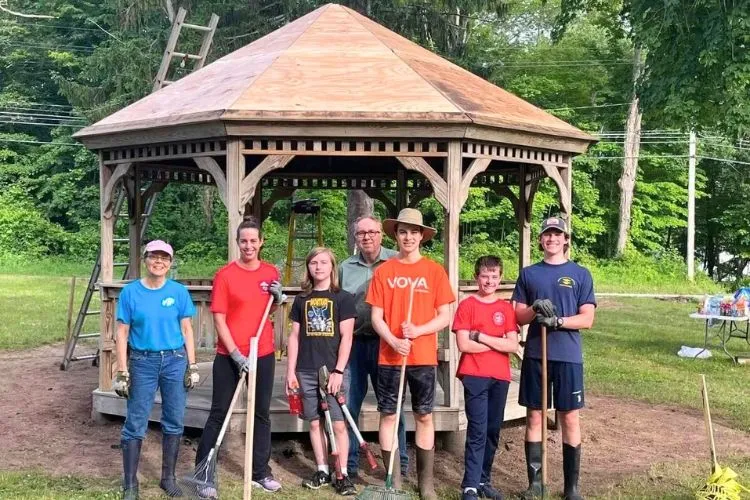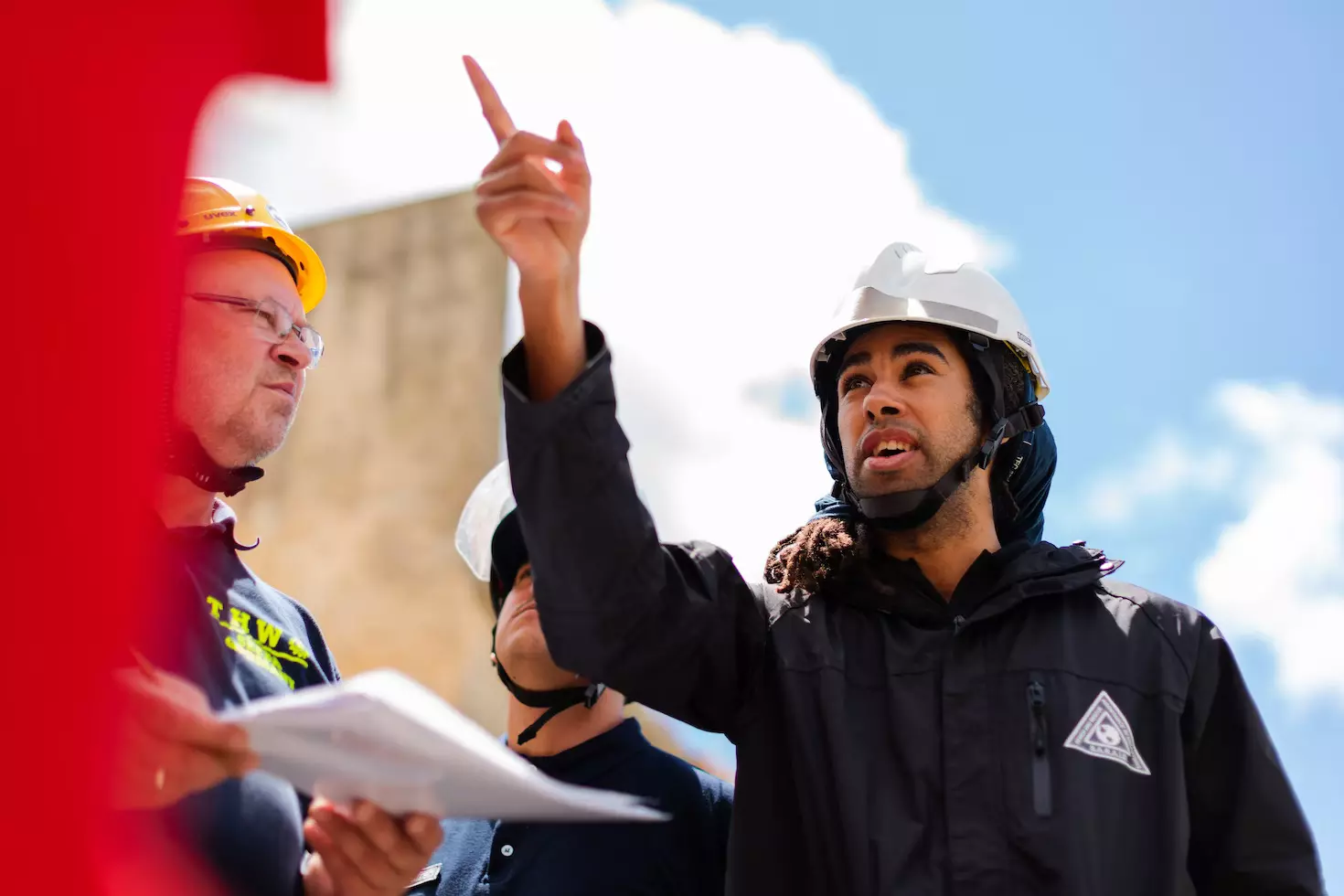So, you’ve chosen your ideal gazebo and can’t wait to see it gracing your backyard. There’s just one obstacle in your way: your concrete base is sloped.
Ensuring your gazebo is level is not just a matter of aesthetics, it’s crucial for structural security and functionality. Intimidated? Don’t be. Let’s learn how to level gazebo on sloped concrete?

Contents
- 1 How To Level Gazebo On Sloped Concrete?
- 2 Frequently Asked Questions (FAQs)
How To Level Gazebo On Sloped Concrete?
Not all slopes are created equal, and before you start leveling your gazebo, it’s vital to understand the gradient of your slope. This can be done using a simple utility level and a straight edge board.
Start by placing one end of your board at the highest point of the slope, and the other at the lowest. Then, use the utility level to identify when the board is horizontal.
The height difference between the two ends of the board is your slope measurement. Understanding this gradient is key, as it directly affects how you approach the leveling process.
Materials and Tools Required
Equipped with your slope measurements, you can now gather the necessary leveling tools. Essential items include a set of sturdy shims, a spirit or laser level, a set of sturdy adjustable or screw jack stands, and solid concrete bases or pavers if you choose to use them. Personal protective gear such as safety glasses and gloves should also be a part of your arsenal.
Options for Leveling a Gazebo
One common method to level a gazebo on sloped concrete is by adjusting the posts. This might mean trimming them to different lengths according to the slope gradient or using adjustable posts that allow for the variance in surface level.

Using Shims and Levelers
Another option is using shims, wooden wedges that can be inserted to adjust the level of your gazebo posts. They are versatile, inexpensive and can be applied easily.
However, the force of gravity and movement from use can dislodge shims over time, so they are more of a temporary solution. For a more permanent fix, levelers can also be installed to the base/posts of the gazebo.
Step-by-Step Leveling Process
Preparation is Key
Before laying a finger on your gazebo, the utmost priority is safety. This means turning off any utilities connected to the gazebo, such as electricity or water lines, to prevent accidents. Once this step is completed, you can proceed with the actual work.
Mark Accurately for Future Adjustments
Using a chalk or a waterproof pencil, pinpoint precisely where adjustments need to be made on your gazebo’s base. This could mean marking lines where you’ll need to cut the posts or where shims and levelers will be placed.
Every cut and alteration should be deliberated and marked before any adjustments are made. Equally important is the constant checking for levelness. Each alteration could affect the equilibrium of the entire structure, so after every change, ensure the gazebo remains level.

Precision in Leveling
With the material in place, carefully adjust until a perfect level is achieved. This might necessitate multiple checks with a spirit level across different points of the gazebo base. Remember, precision here is crucial – even a slight disparity can lead to bigger issues down the line.
Ensuring a Firm Foundation
Now that your gazebo sits proudly level on its sloped base, it’s time to make sure it stays that way. Secure the gazebo onto its new foundation, whether it’s by bolting it down to concrete pavers or anchoring it deep into the ground for those using levelers directly on soil.
This step is not just about stability but also about safety, especially in areas prone to strong winds or seismic activity.
Protection Against the Elements
The choice of materials for shims, levelers, and other adjustments must also take into account their durability and resistance to the elements. If non-resistant materials were used in the interim, now is the time to upgrade to waterproof or weather-resistant alternatives.
Additionally, consider applying a waterproof sealant or protective coating to susceptible areas of the gazebo, especially where any cuts or alterations were made to the posts. This not only ensures the longevity of the materials but also maintains the overall structural integrity of the gazebo.
Routine Checks and Maintenance
After successfully leveling and securing the gazebo, it’s vital to establish a routine for checking its stability and levelness. Environmental factors and regular use can lead to changes in the structure over time.
Periodic inspections will help catch and correct any minor issues before they become major concerns, ensuring your gazebo remains a safe and enjoyable space for years to come.
Adding depth to these aspects of the leveling process underscores the importance of meticulous planning, precision, and long-term care in ensuring your gazebo stands solidly and beautifully, irrespective of the challenges posed by a sloped base.
Safety and Maintenance Checks

Upon completing the setup, ensure to implement checks and balances. This could be as basic as regularly inspecting the gazebo for settlement or shifts in position.
If you’ve used shims, check them for deterioration. Maintenance can also involve tightening fasteners, especially after the initial installation has had time to settle.
Common Pitfalls and How to Avoid Them
Don’t rush into leveling your gazebo without measuring the slope of your concrete base thoroughly. Improper measurements often lead to unnecessary extra work. Check the stability of the gazebo several times during the leveling process to ensure consistent progress.
Expert Advice and Best Practices
Quite often, moisture-related problems when anchoring a gazebo to concrete arise. Solution? Use treated lumber or rust-resistant metals for a durable and strong gazebo. I would recommend consulting professionals or experienced DIY enthusiasts to tackle complex gradients or specialized gazebos to avoid any mishaps.
Finalizing Your Gazebo Setup
After winning the battle against gravity, it’s time to finalize your set-up. Be it melody-making wind chimes or fairy lights that match the theme of your garden, the options are endless. Take pride and enjoy this space – you’ve earned it through your hard work.
You may also find helpful: How To Secure A Gazebo From Wind?
Frequently Asked Questions (FAQs)
How to measure the slope of your concrete base accurately?
To accurately measure the slope of a concrete base, you will need a long, straight board and a level, preferably a 4-foot carpenter’s level for good accuracy. Place one end of the board at the highest point where you plan to install the gazebo and the other end toward where the slope descends. Put the level on top of the board to find where it’s evenly balanced, and measure the distance from the lower end of the board to the ground. This distance is the vertical drop, and when compared to the length of the board, it represents the slope ratio or percentage.
Can you install a gazezebo on any degree of concrete slope?
You can install a gazebo on various degrees of concrete slopes, but the steeper the slope, the more challenging the installation becomes. Minor slopes are relatively easy to accommodate, often requiring simple shims or minor adjustments to post lengths. Moderate to steep slopes may call for more extensive modifications such as cutting or extending posts to varying lengths, customized base leveling materials, or even substantial ground leveling before gazebo installation. Consulting with a structural engineer may be prudent when dealing with significant slopes to ensure safety and stability.
What are the long-term considerations for a gazebo on sloped concrete?
One of the primary long-term considerations for a gazebo installed on sloped concrete is the structure’s stability. Over time, the gravitational pull may cause the gazebo to shift, especially if the slope is steep or if the leveling method isn’t permanent. Regularly inspect the gazebo for any signs of movement or instability. Erosion of the slope or settling of the foundation can impact the levelness of the gazebo, so additional adjustments may be necessary at intervals. Additionally, ensure that water drainage does not compromise the gazebo’s foundation, potentially leading to instability and deterioration.
Conclusion:
Installing a gazebo on sloped concrete might require a bit of grunt work, but with the right preparation, tools, and advice, it’s an achievement within your reach. Remember, your goal is not just creating a wonderful space for relaxation, but also ensuring its stability over time.

Sergio Gomes, a passionate advocate for outdoor living and the male voice behind Shades Authority. With years of experience, Sergio is your trusted source for expert insights on gazebos, pavilions, cabanas, pergolas, and all things outdoor shade solutions. Join him on a journey to transform your outdoor spaces into stunning, functional retreats
